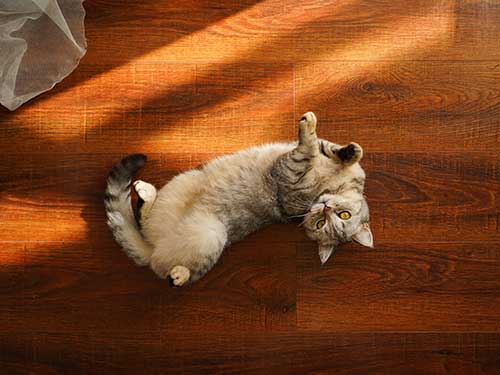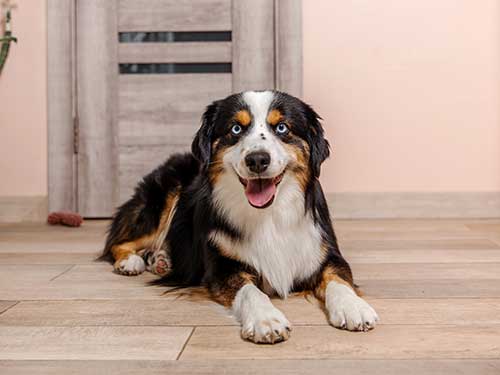Back to Maintenance & Care
Pets and Wood Floor Damage: How to Protect Your Floors
 Pets and wood floors are not always the perfect match. Dog and cat nails can leave scratches, while shedding hair, muddy paws, and the occasional accident all add to the potential damage. Over time, even minor issues can build up and affect the look and durability of your flooring.
Pets and wood floors are not always the perfect match. Dog and cat nails can leave scratches, while shedding hair, muddy paws, and the occasional accident all add to the potential damage. Over time, even minor issues can build up and affect the look and durability of your flooring.
The good news is that with the right care, you don’t have to choose between beautiful hardwood floors and a pet-friendly home. Regular nail trimming is one of the most effective ways to prevent scratches, as pet nails can cut through the protective coating and leave lasting marks. Likewise, spills from food and water bowls can cause staining or warping if not cleaned quickly. To minimise the risk, place bowls on mats or in areas with non-wood flooring, and use walk-off mats near entryways to stop dirt and moisture before it spreads indoors.
With a few simple preventative steps, you can enjoy the warmth of real wood flooring while keeping your pets happy and your home protected. Let’s look at some practical strategies to safeguard your floors from pet-related wear and tear.
Which Flooring Options Are the Most Pet-Friendly?
When you share your home with pets, choosing the right flooring is key to minimising damage and keeping a clean, safe environment. While traditional hardwood is beautiful, it may not always be the most practical option for pet owners because of its susceptibility to scratches and stains.
Engineered wood floors are slightly more durable but have limited sanding potential, which means deep scratches or repeated accidents can be harder to fix over time. Solid wood floors can be refinished more often, but this depends on the manufacturer’s guidelines and the extent of damage.
If durability is your top priority, vinyl flooring (LVT/SPC) is one of the most pet-friendly flooring options. It offers excellent resistance to scratches, dirt, and water, while also being affordable and easy to maintain. With proper care, vinyl can last over 20 years and often comes with warranties of 15 years or more. The downside is that vinyl won’t add as much resale value as hardwood, and it can be difficult to remove once installed. Still, for pet owners, its resilience and low maintenance make it a top choice.
How to Protect Wood Floors from Water Damage
Installing hardwood floors in areas with high moisture, such as bathrooms or kitchens, can lead to serious water damage if not managed properly. Fortunately, there are several preventative steps you can take to protect your investment and extend the life of your flooring.
- Wipe spills immediately: Even small amounts of water can seep into the wood and cause swelling or stains. Quick action helps stop damage before it spreads.
- Use water-free cleaning products: Choose cleaners designed for wood floors that don’t rely on excess water. If mopping is necessary, use a lightly damp microfiber mop instead of a wet one.
- Add surface protection: Place rugs or mats in high-traffic and spill-prone areas to block moisture and dirt. For extra protection, apply a waterproof sealant, but remember it may need reapplication every 12–18 months.
- Consider waxing: Waxing can add water resistance and improve floor shine. However, once applied, wax cannot simply be recoated. The floor will need sanding before refinishing, so weigh this option carefully.
Quick Tips for Extra Protection
- Maintain indoor humidity levels between 40–60% to prevent wood from expanding or shrinking.
- Avoid steam cleaners, as the high heat and moisture can permanently damage wood floors.
- Use trays or mats under pet bowls and plant pots to catch spills before they reach the wood.
- Check windows and doors for leaks regularly to stop water from reaching your floors unnoticed.
Final Thoughts on Pets and Wood Floor Protection
 Owning pets doesn’t mean you have to sacrifice the beauty of your hardwood floors. With a combination of nail trimming, spill prevention, rugs, and the right flooring choices, you can enjoy a pet-friendly home without constant worry about scratches or stains. And when issues do arise, timely cleaning and occasional professional maintenance will help extend the life of your flooring.
Owning pets doesn’t mean you have to sacrifice the beauty of your hardwood floors. With a combination of nail trimming, spill prevention, rugs, and the right flooring choices, you can enjoy a pet-friendly home without constant worry about scratches or stains. And when issues do arise, timely cleaning and occasional professional maintenance will help extend the life of your flooring.
Quick Tips for Pet Owners
- Keep pet nails trimmed to minimise scratches.
- Place mats under food and water bowls to prevent spills from damaging the wood.
- Use walk-off mats at entrances to catch dirt and moisture before it spreads indoors.
- Consider vinyl or LVT flooring in high-traffic pet areas for maximum durability.
- Clean accidents immediately to avoid stains and long-term damage.
FAQs About Pets and Wood Floors
Can pets and hardwood floors coexist?
Yes. With proper care and preventative measures like nail trimming, rugs, and protective mats, you can enjoy both pets and beautiful wood floors in the same home.
What is the best flooring for homes with pets?
While hardwood can work with care, vinyl (LVT/SPC) and laminate are more resistant to scratches and moisture, making them popular choices for pet owners.
How do I protect hardwood floors from pet accidents?
Clean spills immediately and use mats under food bowls or litter trays. Applying a durable protective finish can also add extra resistance against moisture damage.
Do pet scratches on hardwood floors require sanding?
Minor surface scratches can sometimes be polished out, but deeper damage may require professional sanding and refinishing to restore the wood.